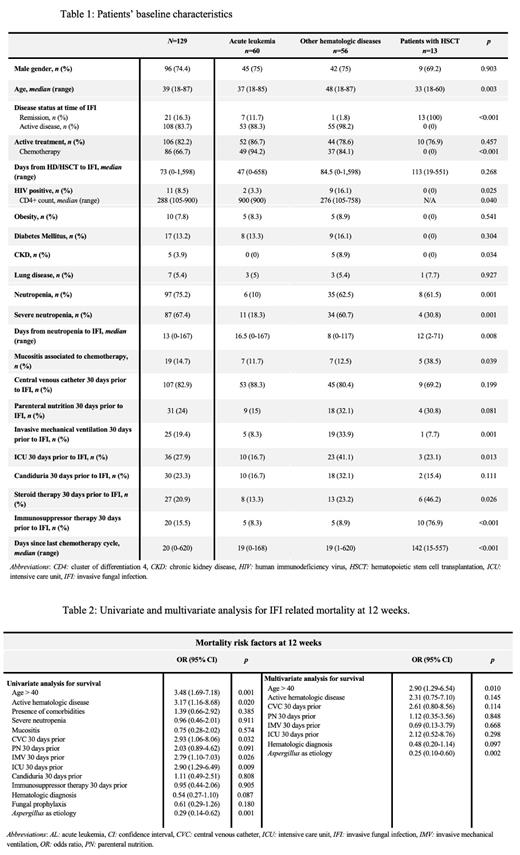Introduction
Although diagnostic and therapeutic strategies for invasive fungal infections (IFI) have evolved in the last decade, their identification and management within patients with hematologic diseases (HD) continues to be a challenge. For this group, in addition to the increased risk of developing an IFI, mortality has been reported as high as 39.1%.
The incidence and etiology vary across regions, suggesting an influence of patient-specific characteristics, environment, and clinician's practices. Literature regarding low- and middle-income countries, reflecting the real-world approach and management for this high-risk group is scarce. Our aim was to describe patients' clinical and microbiological characteristics, treatment strategies, and outcomes in a tertiary care hospital in Mexico City.
Methods
Retrospective single-center study that included all consecutive cases of IFI occurring in adult patients with HD or hematopoietic stem cell transplant (HSCT) between January 2013 and December 2019. We included only proven and probable cases of IFI according to the mycoses study group of the European Organization for Research and Treatment of Cancer (EORTC) guidelines. Clinical data, diagnostic work-up, treatment modalities, and outcomes were extracted from the medical records.
Results
In a total of 119 patients, 129 IFIs were diagnosed; criteria were fulfilled for proven in 38% ( n = 49) and probable in 62% ( n = 80). The median age was 39 years (range, 18-87) and HD was acute leukemia at 46.5%. At the time of IFI, 83.7% had active HD and 82.2% were on active treatment. HSCTs were allogeneic in 11 patients and autologous in 2 patients. A 31.8% and 91.5% presented with at least one comorbidity and/or risk factor, respectively. Severe neutropenia was present in 67.4% with a median of 13 days (range, 0-167) from the start of neutropenia to IFI diagnosis. Additional characteristics are shown in Table 1.
The median time from the HD/HSCT to IFI was 73 days (range, 0-1,598); 30.2% being diagnosed within the treatment induction phase. Identified pathogenswere Aspergillus sp in 62.4%, Candida sp in 21.3%, Mucor spin10.6%, Fusarium sp in 3.5%, and Histoplasma capsulatum in 2.1%. In 10 (7.8%) cases, fungal coinfection was identified.
For proven cases, sites where the microorganism was isolated or identifiedwere: blood 48.3%, lung 25.9%, sinuses 13.8%, CSF 3.4%, bone marrow 3.4%, skin 1.8%,and others 3.4%. For probable IFI, sitesof infection were: lung 91.8%, sinuses 5.9%, and other 2.4%. A 92.8% of aspergillosis and 80% of mucormycosis infections were localized in the lungs, while 86.7% of candidiasis were identified in the blood.
Forty-five (35.4%) patients were receiving antifungal prophylaxis (fluconazole n = 24, itraconazole n = 13, posaconazole n = 3, voriconazole n = 3, anidulafungin n = 2). Antifungal treatment was given to24 (96.1%) of patients; 5 died before IFI diagnosis. Frontline agents included voriconazole ( n = 62), amphotericin n = 26), anidulafungin ( n = 16), caspofungin ( n = 6), fluconazole ( n = 5), clinical trial (posaconazole vs. voriconazole, n = 5) itraconazole ( n = 3), and posaconazole ( n = 1).
Overall survival (OS) at 6 weeks was 59.7% and at 12 weeks was 51.9%. Overall response rate (ORR) was 48.4% ( n=60) and 54.8% ( n=68) at 6 and 12 weeks, respectively.
On univariate analysis risk factors associated with increased mortality at 12-weeks were: age >40 ( p=0.001), active HD ( p = 0.020), CVC 30 days prior to IFI ( p=0.032), IMV 30 days prior to IFI ( p=0.026), and admission to ICU 30 days prior to IFI ( p=0.009). Aspergillosis was associated with reduced 12-week mortality ( p=0.001).On multivariate analysis age >40 ( p=0.010) and aspergillosis (p =0.002) remained independently associated with increased and reduced mortality, respectively.
Conclusion
This study reports unique information regarding proven and probable IFI in hematologic patients diagnosed under EORTC 2020 guidelines. Our epidemiology was similar to that reported by other countries, including most common etiologic agents and a higher proportion of AL and on active chemotherapy patients.Mortality rates were higher, possibly explained by the exclusion of possible IFI cases, higher proportion of active primary disease, and limited antifungal prophylaxis. Better survival among patients with aspergillosis, suggest that current diagnostic tests lead to earlier diagnosis and treatment with an impact on patients' prognosis.
Disclosures
No relevant conflicts of interest to declare.


